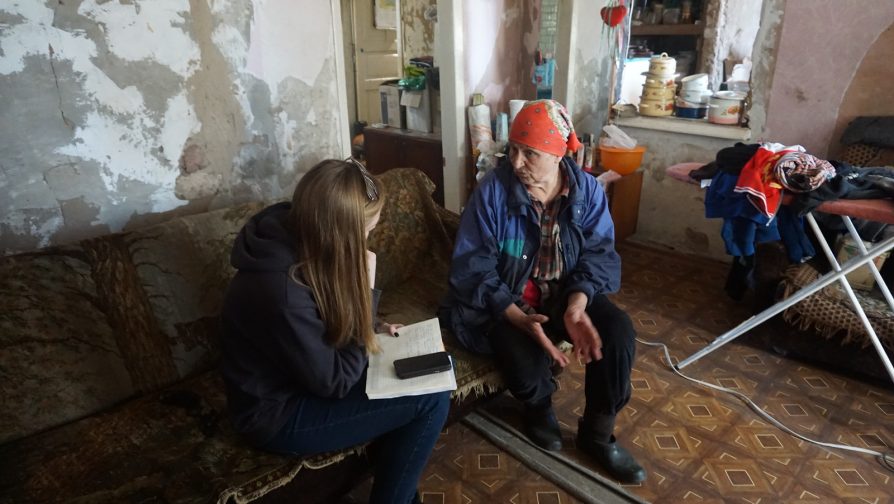After shelling in 2014, the roof of Liudmyla’s house was damaged by shrapnel., one corner of the house was virtually destroyed and a wall of the house was on the verge of collapse.

Liudmyla Aptasova, 65, whose fate had brought her from Kazakhstan to Ukraine, could never have imagined the turn life would take for her family in the small, peaceful town of Stanytsia Luhanska, located in the eastern part of the country.
Today, her whole life is focused on her teenage grandchildren Valerii, 17, and Roman, 15, and a small house gradually healing from the wounds of war.
In 2014, military hostilities struck Stanytsia Luhanska and the town suffered fierce bombing that summer.
The family did not leave home all this time. Liudmyla, her grandchildren and husband Oleksandr were hiding under the beds in the smallest room of their house.
“We could not leave because we did not have money nor a place to go. Those who fled, left their pets with us. I also looked after abandoned houses,” recalls Liudmyla.

Life on the edge
On 18 August 2014, there was extremely heavy shelling. Liudmyla’s house was caught in the crossfire. Shockwaves blew out all the windows.
“I had just gone to the garden. The boys were in the house. Suddenly, a thundering sound engulfed us, I lost my breath and fell into the vegetable garden bed. At that moment, my grandchildren leapt out of the half-ruined house and pulled me out of the garden, a split second before another shell struck our property,” says Liudmyla.
The roof was damaged by shrapnel. One corner of the house was virtually destroyed and a wall of the house was on the verge of collapse.
Trying to survive
For a long time Liudmyla did not dare to ask anyone for help to rebuild the house. The family tried to cope on their own. Moreover, Liudmyla had to care for her gravely ill husband Oleksandr. At the time, her grandchildren became her main support.
“Valerii and Roman managed to close the gaping holes in the roof with building foam. However, after a while, the foam simply dried up; the first rains showed that we needed serious help,” recalls Liudmyla.
The woman tried to receive glass from local authorities for the damaged windows. Nonetheless, she was refused, turned away because others had more severe needs.
“I then gave up on the idea of asking for help. A neighbour, though, suggested to approach the Norwegian Refugee Council (NRC). So, I decided to try my luck again. After some time, NRC engineers arrived to assess our damaged house, ” says Liudmyla.
Long-awaited assistance
The family was approved for assistance through an NRC heavy repair project financed by the UN Refugee Agency.
“We received bricks, timber, roofing slate, cement, materials for insulation and cash for construction works,” says Liudmyla.
The head of the family – Liudmyla’s husband Oleksandr – died a year ago.
“The process of repair helped me to recover from a bitter loss. I actively participated throughout the reconstruction. By the times of the first autumn rains, we already had a new roof over our heads,” noted Liudmyla.
Liudmyla slightly expanded the living space of the house, because she had enough building materials for this. So there is an extension, which she wants to make into a full kitchen. In a relatively short time, the family managed to restore the roof, build new walls and insulate the house.
“The project includes repair of the roof, walls and windows. In addition, a key objective is to secure the integrity of the house and restore loadbearing structures. First and foremost, we aim to have a safe and warm house,” emphasized the NRC shelter project coordinator, Mykhailo Kyslynskyi.
Still vulnerable and in need
Even today, the sounds of artillery and gunfire are still audible, frightening the local population in Stanytsia Luhanska.
“I am very much afraid that our newly renovated house could be shelled again,” admits Liudmyla.
The family of three survives on Liudmyla’s pension of about 100 US dollars a month. Liudmyla raises goats and sells milk to make ends meet.
“We stopped using gas heating two years ago. Last winter we used a homemade stove to warm the house, fuelling it with the remnants of the old wooden boards from the destroyed roof. It does not provide strong heat, but we have no other option either,” says Liudmyla.
Future steps
Despite the repair of the exterior, the house still needs serious work on the interior. To do this, the family will require additional building materials: gravel, cement and timber. It also requires a serious financial investment – and hard work from family members.
“We will try to continue the house repair on our own. My grandchildren promised to help me with this. In memory of my late husband and for the sake of my grandchildren’s future, I don’t want this house to fall into disuse,” says Liudmyla.
In 2018, with the support of the UN Refugee Agency, NRC assisted 750 people to repair 356 houses.
Share on Facebook Share on Twitter